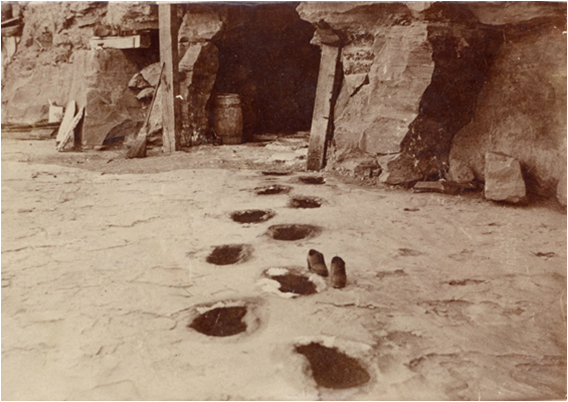Fossils
The sandstone quarry at the Nevada State Prison was a busy place in the late 1870’s as the demand for sandstone building blocks was increasing. As layer after layer of sandstone was cut from the quarry, a wealth of fossils and fossilized tracks were revealed, including bison, mammoth, horse, deer, and wolf. At a layer near the current floor of the quarry, an amazing discovery took place: the tracks of a species whose footprints, at first glance, appeared to be those of a giant human.

Buried Within the Quarry
Prehistoric Creatures
In the late 1870s inmates working to quarry stone in the prison discovered the fossilized footprints of prehistoric creatures.
In 1882, the Carson City Sheriff communicated the discovery of the footprints to the California Academy of Science in San Francisco.

Discovered in Stone
Giant Humans!?
Measuring 18-21 inches in length and 8-9 inches wide, the foot prints were brought to the attention of a scientist at the California Academy of Sciences in San Francisco. The footprints were correctly identified as La Brea Fauna of the Pliocene era, but the scientist declared that they belonged to a previously undiscovered race of giant humans. Their age would be approximately 2 million years old. The scientist explained the lack of human foot contours by suggesting that the person might have worn sandals.
Other scientists reviewed the evidence and concluded the fossilized prints were those of a giant sloth who lived about 1.6 million years ago. This species was bi-pedal part of the time, which would account for the similarities with hominids.

Controversial Explanation
Giant Sloth
In the end, the sloth advocates won out in 1917. Other prints include mammoths, native horses, large birds, dire wolves, and the sloths, big-toothed cats, elk and deer.
As late as 2013, scientific study has been carried out on footprints uncovered to the South of the License Plate Factory. While the fossil grotto may be compromised, the general area is a rich site of historic significance, suitable for scientific research and demonstration.

1893 Chicago World's Fair
Columbian Exposition
While the scientific evidence was overwhelmingly in favor of the giant sloth explanation, those who believed in the giant human theory persisted well into the turn of the century. Papers representing both sides were written and debated. The footprints were exhibited at the Columbian Exposition, Chicago World’s Fair, in 1893.
